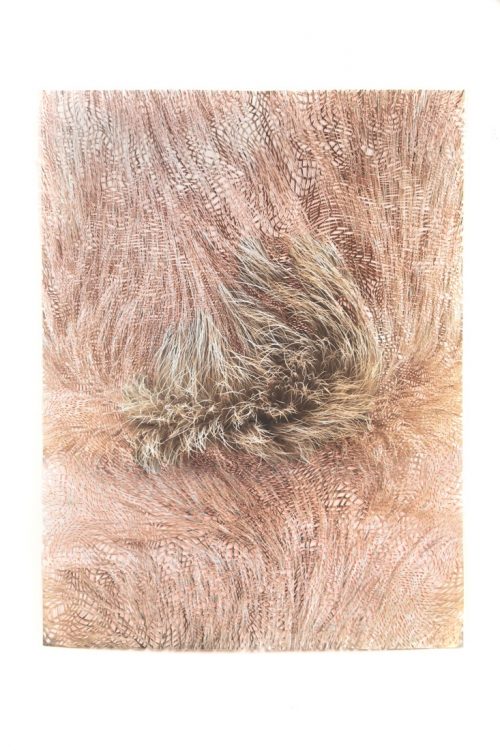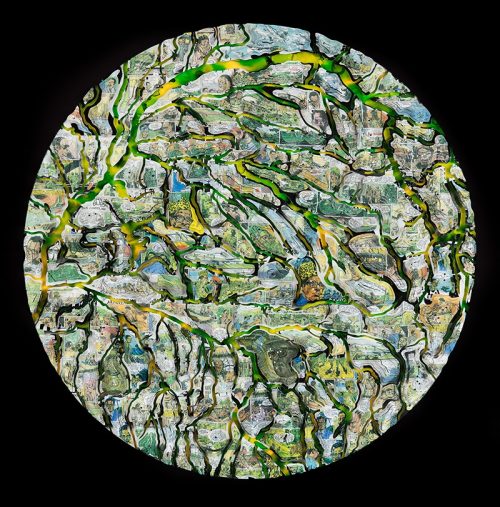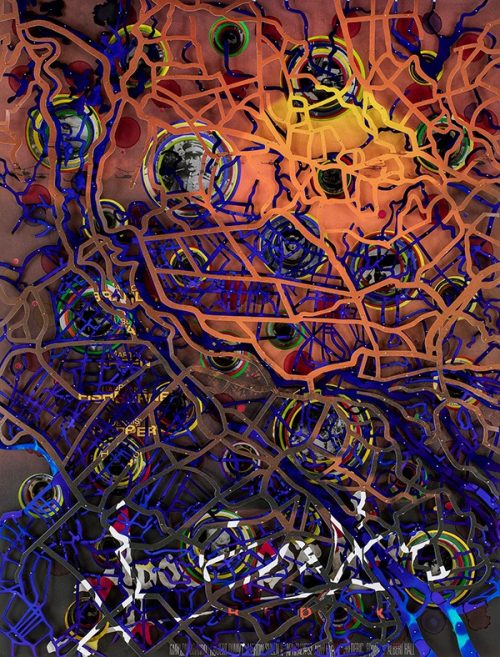This content was published: September 16, 2019. Phone numbers, email addresses, and other information may have changed.
Cuttings
Rock Creek Helzer Gallery

Laura Vandenburgh, Matter (Lick), 2019
Inkjet print, water color, and paper
Courtesy of the Artist
- Artists
- Ben Buswell
- Jeffry Mitchell
- Matthew Picton
- Laura Vandenburgh
- Dates
- September 16 – October 17, 2019
- Artist talk and gallery reception
- October 9, 11am-12 noon
- Gallery hours
- Monday – Friday 9am-5pm
- Saturdays 9:30am-4:30pm (free parking!)

Matthew Picton, The History of the Congo #1, 2018
Archival papers, boards
Courtesy of the Artist and Elizabeth Leach Gallery
The paper cut out originated as a folk-art tradition in sixth century China, where paper was invented only a few hundred years earlier. In the Western tradition, cut paper was first accepted as a form of “high art” when the Cubists began making collages to push the two-dimensional image toward a more sculptural presence. From here, collage was adopted by the Surrealists and many other artists, including Henri Matisse whose colorful paper cut outs informed a new aesthetic in his work. Around the same time, the Italian artist Lucio Fontana undermined the primacy of the picture plane in favor of the experience of space by slashing his monochrome paintings with a razor. In doing so, Fontana put forward the idea that the cut was not a means to an end, but the end itself. The cut became the vehicle for content and meaning. Since Modernism, many artists have used the cut to create meaning, as well as an opportunity to investigate images and perception. The four artists in Cuttings work along these lines with varied and individual approaches that reflect on contemporary themes.

Matthew Picton, Apocalypse, 2018
Archival papers, boards
Courtesy of the Artist and Elizabeth Leach Gallery
Ben Buswell pushes at the limits of materiality to privilege bodily awareness over symbolic reading. In his work, the mediums and processes are the content. In Arbiter (Iris) Buswell literally wounds a bound paper body and then efforts to repair the damage with language. In his photographic works, images taken at sites from American colonial history are methodically brought back into the present moment through meditative embellishment.
Jeffry Mitchell’s ebullient ceramics and drawings include cuttings in a way that undermines the function and preciousness of the work. Pretzel Pot borrows the form of a traditional ceramic vessel yet is perforated throughout, rendering it useless as a container and highlighting the work’s imagery and immediacy. Mitchell’s art is laden with an iconography he relates to universal childhood imagery: flowers, bunnies, elefants (the artist appropriately prefers the “f” over “ph” spelling), and bears. His drawings are filled with the same imagery, then folded and cut like children’s snowflake decorations, both a playful and unprecious gesture.
The paper sculptures by Matthew Picton include cut out maps of actual places juxtaposed with related images culled from films, cartoons, posters, and photographs. The stacked layers of cut paper create sculptural relief and read as objects or scaffolding for images that question historical perspective, imperialism, racism, and power.
In her Matter series, Laura Vandenburgh blows up photographs of actual textures that appear physical, yet are disrupted by cut out networks drawn on the backs of the pieces and arbitrarily cut out. These patterns break the dimensional illusion of the image while creating another dimensionality of their own. The colorful reflected light, visible through the cuts, perceptually unifies the emotive and sculptural whole.
Petra Sairanen
Helzer Gallery Director
Works: Ben Buswell courtesy of the artist and Upfor, Jeffry Mitchell courtesy of the artist and PDX Contemporary Art, Matthew Picton courtesy of the artist, Elizabeth Leach Gallery and the PCC Rock Creek Art Collection, Laura Vanderburgh courtesy of the artist
